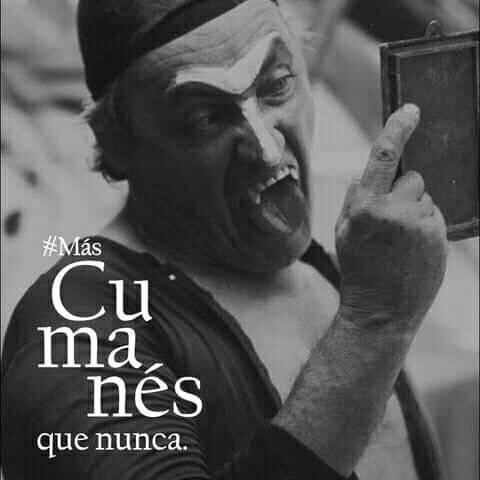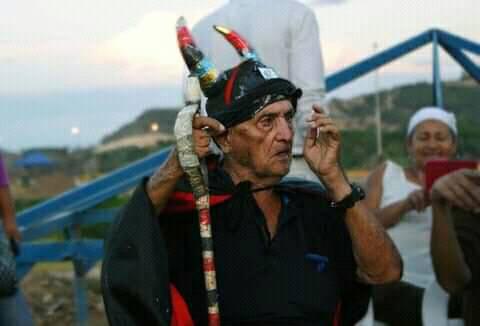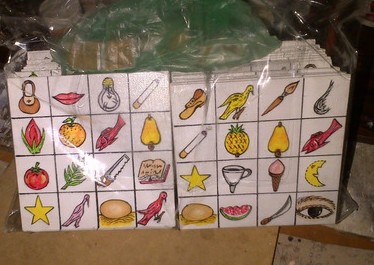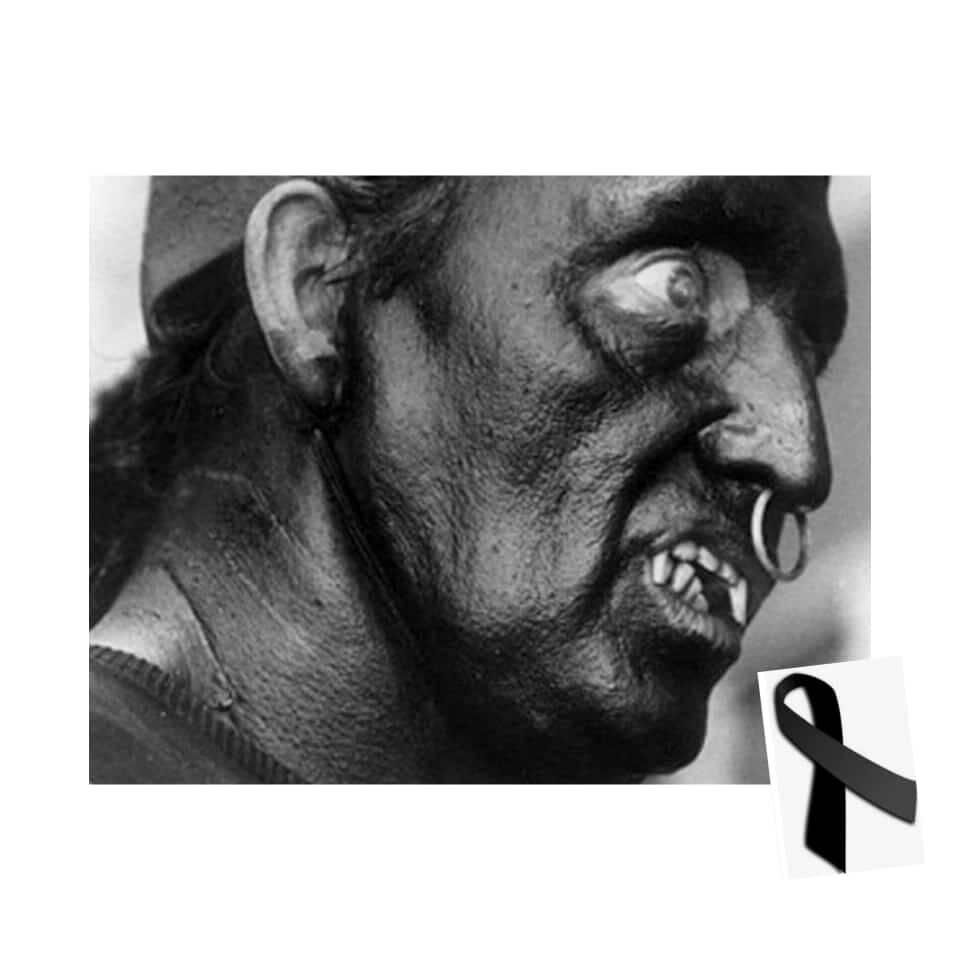A cordial greeting to the friends of the magnificent #hive community, this time I bring you the biography Luis Hurtado (the devil of Cumaná who was a living cultural heritage of Venezuela for many years.
Un saludo cordial a los amigos de la magnífica comunidad de #hive en esta oportunidad les traigo la biografía Luis Hurtado (el diablo de Cumaná quien fue patrimonio cultural de Venezuela viviente por muchos años.

LUIS DEL VALLE HURTADO: The Devil of Cumaná.
First I disguised myself as an Indian, like at age 20 working in a store called Almacén La Princesa on Avenida Bermúdez, there I disguised myself as a clown, as San Nicolás and then in the 1940s I began to dress as a Devil.
LUIS DEL VALLE HURTADO: El Diablo de Cumaná.
Primero me disfrazaba de indio, como a los 20 años trabajando en una tienda llamada Almacén La Princesa de la Avenida Bermúdez, allí me disfrazaba de payaso, de San Nicolás y luego por los años 1940 comencé a vestirme de Diablo
Path of Life:
Luis Del Valle Hurtado, was born in the San Francisco de Cumaná neighborhood, on January 12, 1932, to his parents Juan José Acuña, a native of Cumanacoa, well-known editor, typographer and journalist, founder of the Cuman newspaper "El Renacimiento" and Luisa Hurtado , native of Carúpano. His life has always been linked to disguise, “... first I disguised myself as an Indio, like at 20 years of age working in a store called Almacén La Princesa on Avenida Bermúdez, there I would disguise myself as a clown, as San Nicolás and then as a In the 1940s I began to dress as Diablo ... "He is also known as Tarzan, a popular character who set a pattern in his life by going out disguised as such through the streets of Cumania. He also disguised himself as Indio Colorao; he also played the role of Dracula in some activities and dramatizations But ultimately, it is with his two performances of Diablo Rojo and Diablo Negro, which marked a milestone in the popular culture of Sucre and Venezuela. The Nueva Andalucía film team produced a documentary about his life and art entitled "El Diablo de Cumaná ”, directed by John Dickinson and awarded at various film festivals. During those years he was recognized as Best National Short Film Actor. He was also awarded the N Award National of Folkloric Dance 1984, the declaration of Living Cultural Heritage of the Sucre State in 1994 and Honorary Teacher of the University of Arts UNEARTES in 2012.
Ruta de Vida:
Luis Del Valle Hurtado, nació en el Barrio San Francisco de Cumaná, el 12 de Enero de 1932, sus padres Juan José Acuña, oriundo de Cumanacoa, conocido editor, tipógrafo y periodista, fundador del Diario cumanés “El Renacimiento” y de Luisa Hurtado, nativa de Carúpano. Su vida siempre ha estado vinculada al disfraz, “...primero me disfrazaba de Indio, como a los 20 años trabajando en una tienda llamada Almacén La Princesa de la Avenida Bermúdez, allí me disfrazaba de payaso, de San Nicolás y luego por los años 1940 comencé a vestirme de Diablo..." Es también conocido como Tarzán, personaje popular que marcó una pauta en su vida al salir disfrazado como tal por las calles cumanesas. Se disfrazó también de Indio Colorao; igualmente hizo el papel de Drácula en algunas actividades y dramatizaciones Pero en definitiva, es con sus dos escenificaciones de Diablo Rojo y Diablo Negro, que marcó un hito en la cultura popular sucrense y venezolana. El equipo cinematográfico Nueva Andalucía le produjo un documental sobre su vida y su arte titulado “El Diablo de Cumaná”, dirigida por John Dickinson y premiada en diversos festivales de cine. Por esos años fue recocido como Mejor Actor Nacional cinematográfico de cortometrajes. Asimismo le fue conferido el Premio Nacional de Danza Folklórica 1984, la declaratoria de Patrimonio Cultural Viviente del Estado Sucre en 1994 y Maestro Honorario de la Universidad de las Artes UNEARTES en 2012.
Character:
He says that he was very interested in the so-called Diablos Cara e totuma that at the time roamed the streets of Cumaná with their colorful masks and their dance. In an interview with Eleazar Guillen he tells him “… Years passed and one day, observing an image of the struggle between good and evil and Saint Michael the Archangel that was revealed, I felt a certain attraction for this figure. With that color, horns and wings, he made many feel afraid. I went to the old slaughterhouse that was in Caigüire and from there I took some chunks that I stuck on my dad's hat. With several cardboard boxes I reinforced them, I joined them, I made with them wings like those of the Devil and with the ropes and wires I made myself a tail, at the end I smeared my body with dust, black smoke (soot), soot ... " He says that his baptism as the Devil of Cumaná occurred in the 1970s, when together with María Rodríguez and the Chigüao Brothers they appeared at the Palacio de las Industrias in Caracas.

El Personaje:
Cuenta que le llamaba mucho la atención los llamados Diablos Cara é totuma que por la época recorrían las calles de Cumaná con sus máscaras coloridas y su danza. En entrevista a Eleazar Guillen le relata “…Transcurrieron años y un día, observando una imagen de la lucha entre el bien y el mal y a San Miguel Arcángel que se reveló, sentí cierta atracción por esta figura. Con ese color, cachos y alas, hacía que muchos sintieran miedo. Me fui al viejo matadero que se encontraba en Caigüire y de allí tomé unos cachos que pegué en un sombrero de mi papá. Con varias cajas de cartón las reforcé, las uní, hice con ellas una alas como las del Diablo y con las cabuyas y alambres me hice un rabo, al final unté mi cuerpo con el polvillo, humo negro (hollín), tizne…” Se dice que su bautizo como el Diablo de Cumaná se dió por los años 1970, cuando junto a María Rodríguez y los Hermanos Chigüao se presentaron en el Palacio de las Industrias en Caracas.
Theater, music and dance:
According to Ramón Yánez, Luis Hurtado with his creation of “Humanized Devil” “… managed to transform it into the representation of one of the most popular traditions of the Sucre state, which by projecting our city has exhibited its mixture of song, dance, theater, and drama of the people ”. At the sound of a large empty kettle or tin, containers of oil or vegetable shortening, struck with two drumsticks defining characteristic peals, creating or giving strength to the spooky space, he walks the streets pretending to chase people, then he performs some stations where he stages a ritual that includes dance, song and parliament. "There comes the Devil through the alley, in the cachos he brings coffee and paper, let him come, let him come", then launching a loud and characteristic laugh: Ha, ha, ha, ha, ha ... Parliament or wordiness is a account of his actions and his own recognitions, along with advice to children and adolescents, that is why he calls himself a "Good Devil" for the transmission of values, he is a teacher, an educator, a multifaceted, sensitive and human man who leaves aside from the evil attributed to the Devil he represents. A drummer (Aparicio or Emilio, their longtime drummers) and an Indian participate in this ritual, a character who is also part of the ritual.
El teatro, la música y la danza:
Según Ramón Yánez, Luis Hurtado con su creación de “Diablo humanizado” “…logró transformarlo en la representación de una de las tradiciones más populares del estado Sucre, que proyectando nuestra ciudad ha exhibido su mezcla de canto, danza, teatro, drama del pueblo”. Al sonar de una perola o lata grande vacía, recipientes de aceite o manteca vegetal, percutido con dos baquetas definiendo unos repiques que le son característicos, creando o dándole fuerza al espacio espeluznante, recorre las calles fingiendo perseguir a la gente, luego va realizando algunas estaciones donde escenifica un ritual que comprende la danza, canto y parlamento. “Allá viene el Diablo por el callejón, en los cachos trae café y papelón, déjalo que venga, déjalo que venga”, lanzando luego una fuerte y característica carcajada: Ja, ja, ja, ja, ja… El parlamento o palabreo es un relato de sus acciones y reconocimientos propios, junto a consejos a los niños y adolescentes, es por ello que se autodenomina un “Diablo Bueno” por la transmisión de valores, es un maestro, un educador, un hombre polifacético, sensible y humano que deja de lado la maldad atribuida al Diablo que representa. En este ritual participa un tamborero (Aparicio o Emilio, sus tamboreros de trayectoria) y un indio, personaje que también forma parte del ritual.
The manifestation and cultural identity: The Dancing Devils of Corpus Christi in Venezuela were recently recognized as an intangible heritage of humanity by UNESCO, their expressive force, the magical religious connotation; in this case popular religiosity combines various elements of the sacred and profane; Between good and bad. Even though they are two different manifestations, it is still a recognition of the entire Venezuelan Diablada. Human events have their temporary allegories, the presence of Luís Hurtado as Diablo Mayor Sucrense has been linked almost exclusively to the carnival, undermining and multiplying this expression, making the so-called "little devils" reappear that have been constantly making the preamble to the carnestolendas throughout the world. Sucre state; Carnival, characterized as a time to reverse roles, for teasing, for psychological expansion and crazy costumes in the natural setting of a creator from Sucre who has dedicated his entire life to living together and balancing good and evil. Without a doubt, we are in the presence of a genuine expression of religious cultural identity.
La manifestación y la identidad cultural: Los Diablos Danzantes de Corpus Christi de Venezuela recientemente fueron reconocidos como Patrimonio intangible de la humanidad por la UNESCO, su fuerza expresiva, la connotación mágica religiosa; en este caso la religiosidad popular conjuga diversos elementos de lo sagrado y profano; entre el bien y el mal. Aun cuando son dos manifestaciones distintas, no deja de ser un reconocimiento a toda la Diablada Venezolana. Los hechos humanos tienen sus alegorías temporales, la presencia de Luís Hurtado como Diablo Mayor sucrense se ha vinculado casi exclusivamente al carnaval, minando y multiplicando esta expresión, haciendo resurgir los llamados “diablitos” que constantemente vienen haciendo el preámbulo de las carnestolendas en todo el estado Sucre; el Carnaval, caracterizado como época para invertir roles, para el juego de burlas, para la expansión psicológica y los disfraces disparatados en el escenario natural de un creador sucrense que ha dedicado toda su vida a convivir y equilibrar el bien y el mal. Sin duda, estamos e presencia de una expresión genuina de la identidad cultural relional.
Luis Hurtado, the lottery maker: the handcrafted painted card and token lottery is a very popular game throughout the state of Sucre, which becomes a meeting point in urban neighborhoods, hamlet towns, particularly those made in Carúpano, Paira and cumana. It is an ingrained custom in many communities in the afternoons or weekends, in the house of a neighbor, the patio and playing. Luis Hurtado, since he was 14 years old, has maintained this tradition as a result of his creativity and ingenuity. Previously, the so-called cardboard drawings were painted on paper that was later glued with starch and gum arabic, the number of cardboard goes from 30 to 150. Today they are made of papier-mâché or wood veneers in a size of 9 * 13 cm, with a distribution of 16 drawings; in some cases they have 8 drawings (four in the middle and four in the corners) in figures or tokens they can have between 30 to 80, which before I painted on paper and stuck on soda caps of the siphon glue, today they are small painted wooden circles With enamel, the figures of objects and animals that it has are the following: rooster, flag, 3 balls, pitalaya, mango, bird, snake, the boat, the feather, the square, cup, ladder etc. The singing of the chips is a spectacle, which are in a cloth bag, sometimes reference is made to actions to discover the chips without mentioning them such as: (it is raining) to refer to the umbrella (the one with the sancocho) for the hen and etc. It is rotated between each of the players in each hand or new game, the singer begins by saying: (hand and bag) before putting the hand to get the first chip that will then be repeated until (they cast the lottery)
Luis Hurtado, el fabricante de loterías: la lotería de fichas y cartulinas pintadas artesanalmente es un juego muy popular en todo el estado de Sucre, que se convierte en un punto de encuentro en barrios urbanos, pueblos caseríos, particularmente los que se hacen en Carúpano, Paira y cumaná. Es una costumbre arraigada en muchas comunidades en las tardes o fines de semana, en la casa de un vecino, en el patio y jugando. Luis Hurtado, desde los 14 años, ha mantenido esta tradición como resultado de su creatividad e ingenio. Anteriormente, los llamados dibujos de cartulina se pintaban sobre papel que luego se pegaba con almidón y goma arábiga, el número de cartones va de 30 a 150. Hoy están hechos de papel maché o chapas de madera en un tamaño de 9 * 13 cm, con una distribución de 16 dibujos; en algunos casos tienen 8 dibujos (cuatro en el medio y cuatro en las esquinas) en figuras o fichas pueden tener entre 30 a 80, que antes pintaba en papel y pegaba tapas de soda del pegamento sifón, hoy son pequeñas círculos de madera pintados Con esmalte, las figuras de objetos y animales que tiene son las siguientes: gallo, bandera, 3 bolas, pitalaya, mango, pájaro, culebra, el bote, la pluma, el cuadrado, copa, escalera etc. El canto de las patatas fritas es un espectáculo, las cuales están en una bolsa de tela, a veces se hace referencia a acciones para descubrir las patatas fritas sin mencionarlas como: (está lloviendo) para referirse al paraguas (el del sancocho) para la gallina y etc. Se rota entre cada uno de los jugadores en cada mano o juego nuevo, el cantante comienza diciendo: (mano y bolso) antes de poner la mano para sacar la primera ficha que luego se repetirá hasta que (echen la lotería)

Something that is not mentioned in his biography and is clearly public knowledge is that he painted himself black with newspaper ashes, then he began to use coal ash with oil, which made his eyes red from allergies until he lost his vision one eye, a trident in hand, and a beet juice pot along with false fangs for an illusion of blood and terror, although others tried to imitate it, none had that terrifying attitude that ran from children and adults of the world. fear that he transmitted since his facial features accompanied him, this man was used by the rulers and taken to various countries in Europe to dance, and then he was seen dancing through the streets with a can in his hands asking for collaboration since he was poorly paid As a cultist and despite all the fame I lived in a very humble house, in the concert band where I currently work as musicians we were asked to play in tribute and I confess that I could not go since it scared me a lot when ndo child so I thought of paying tribute to him by sharing his life and work with the world.
Algo de lo que no se menciona en su biografía y es de conocimiento netamente público es que se pintaba de negro con cenizas de periódico, luego comenzó a usar ceniza de carbón con aceite, lo que le ponía los ojos rojos por alergias hasta perder la visión de un ojo, un tridente en la mano, y un embace con jugo de remolacha junto con unos colmillos postizos para una ilusión de sangre y terror, aunque otros lo trataron de imitar, ninguno tenía esa actitud aterradora que hacia correr desde niños y adultos del miedo que trasmitía ya que sus rasgos faciales lo acompañaban, este señor fue utilizado por los gobernantes y llevado a varios países de Europa a danzar, y luego se le veía danzando por las calles con una lata en las manos pidiendo colaboración ya que era mal pagado como cultor y pesar de toda la fama vivía en una casa muy humilde, en la banda de concierto donde trabajo actualmente como músicos se nos pidió tocarle en homenaje y les confieso que no pude ir ya que me asustaba mucho cua ndo niño asi que pensé en rendirle tributo compartiendo su vida y obra con el mundo.

all images are from my gallery
todas las imágenes son de mi galería
Congratulations @rubenalejandro01! You have completed the following achievement on the Hive blockchain and have been rewarded with new badge(s) :
Your next target is to reach 400 upvotes.
You can view your badges on your board and compare yourself to others in the Ranking
If you no longer want to receive notifications, reply to this comment with the word
STOPYour content has been voted as a part of Encouragement program. Keep up the good work!
Use Ecency daily to boost your growth on platform!
Support Ecency
Vote for Proposal
Delegate HP and earn more